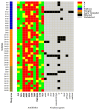Characteristics of Pathogenic Escherichia coli Associated with Diarrhea in Children under Five Years in Northwestern Ethiopia
- PMID: 38535888
- PMCID: PMC10975463
- DOI: 10.3390/tropicalmed9030065
Characteristics of Pathogenic Escherichia coli Associated with Diarrhea in Children under Five Years in Northwestern Ethiopia
Abstract
Diarrheagenic Escherichia coli (DEC) are the leading cause of infectious diarrhea and pose a significant global, regional, and national burden of disease. This study aimed to investigate the prevalence of six DEC pathotypes in children with diarrhea and determine their antibiotic resistance patterns. Samples from 107 diarrheagenic children were collected and processed for Escherichia coli (E. coli). Single-plex PCR was used to detect target virulence genes as well as characterize and categorize DEC pathotypes. Antibiotic resistance patterns were determined by the Kirby-Bauer disk diffusion method. E. coli was detected in 79 diarrheal stool samples, accounting for 73.8% of the samples collected. Additionally, 49.4% (39 out of 79) of the isolates harbored various typical virulence factors. Results revealed six pathotypes of virulence: enterotoxigenic E. coli (ETEC) (53.8%), enteropathogenic E. coli (EPEC) (12.8%), enteroaggregative E. coli (EAEC) (10.3%), Heteropathotypes (7.8%), Shiga toxin-producing E. coli (STEC), and enterohemorrhagic E. coli (EHEC) (7.7% each). The isolates exhibited high antibiotic resistance against trimethoprim/sulfamethoxazole (82.1%), amoxicillin (79.5%), ampicillin (74.4%), gentamicin (69.2%), and streptomycin (64.1%). An overall occurrence of 84.6% of multiple-drug resistance was observed in the isolates, with resistance ranging from three to four antibiotic classes. Our findings revealed a high level of pathogenic E. coli that were highly resistant to multiple categories of antibiotics among children in the Awi zone. These findings highlight the potential role of pathogenic E. coli in childhood diarrhea in tropical low-resource settings and underscore the need for continued research on the characteristics of pathogenic and antibiotic-resistant strains.
Keywords: Awi zone; children; diarrheagenic Escherichia coli; resistance; virulent genes.
Conflict of interest statement
The authors declare that they have no conflicts of interest with respect to this work.
Figures



Similar articles
-
Molecular identification of diarrheagenic Escherichia coli pathotypes and their antibiotic resistance patterns among diarrheic children and in contact calves in Bahir Dar city, Northwest Ethiopia.PLoS One. 2022 Sep 28;17(9):e0275229. doi: 10.1371/journal.pone.0275229. eCollection 2022. PLoS One. 2022. PMID: 36170263 Free PMC article.
-
Detection and antibiotic resistance of diarrheagenic Escherichia coli from patients with diarrhea in Ulaanbaatar, Mongolia.J Infect Dev Ctries. 2023 Feb 28;17(2):202-209. doi: 10.3855/jidc.17256. J Infect Dev Ctries. 2023. PMID: 36897900
-
Antibiotic resistance and virulence patterns of pathogenic Escherichia coli strains associated with acute gastroenteritis among children in Qatar.BMC Microbiol. 2020 Mar 6;20(1):54. doi: 10.1186/s12866-020-01732-8. BMC Microbiol. 2020. PMID: 32143566 Free PMC article.
-
Pathotyping and Antibiotic Resistance Profiling of Escherichia coli Isolates from Children with Acute Diarrhea in Amatole District Municipality of Eastern Cape, South Africa.Biomed Res Int. 2020 Nov 19;2020:4250165. doi: 10.1155/2020/4250165. eCollection 2020. Biomed Res Int. 2020. PMID: 33294442 Free PMC article.
-
Antimicrobial Resistance in Diverse Escherichia coli Pathotypes from Nigeria.Antibiotics (Basel). 2024 Sep 26;13(10):922. doi: 10.3390/antibiotics13100922. Antibiotics (Basel). 2024. PMID: 39452189 Free PMC article. Review.
Cited by
-
Virulence and Antibiotic Resistance of aEPEC/STEC Escherichia coli Pathotypes with Serotype Links to Shigella boydii 16 Isolated from Irrigation Water.Pathogens. 2025 Jun 1;14(6):549. doi: 10.3390/pathogens14060549. Pathogens. 2025. PMID: 40559557 Free PMC article.
-
Medicinal plants: bioactive compounds, biological activities, combating multidrug-resistant microorganisms, and human health benefits - a comprehensive review.Front Immunol. 2025 Apr 28;16:1491777. doi: 10.3389/fimmu.2025.1491777. eCollection 2025. Front Immunol. 2025. PMID: 40375989 Free PMC article. Review.
-
Prevalence of Shiga toxin-producing Escherichia coli, Salmonella, and Campylobacter species among diarrheal patients from three major hospitals in Ethiopia.PLOS Glob Public Health. 2025 Apr 21;5(4):e0004407. doi: 10.1371/journal.pgph.0004407. eCollection 2025. PLOS Glob Public Health. 2025. PMID: 40258000 Free PMC article.
-
Genomic insights into antimicrobial resistance and virulence of E. coli in central Ethiopia: a one health approach.Front Microbiol. 2025 Jun 10;16:1597580. doi: 10.3389/fmicb.2025.1597580. eCollection 2025. Front Microbiol. 2025. PMID: 40556891 Free PMC article.
-
Emerging multi-drug resistant and extended-spectrum β-lactamase (ESBL)-positive enterotoxigenic E. coli (ETEC) clones circulating in aquatic environments and in patients.One Health. 2025 Jan 10;20:100968. doi: 10.1016/j.onehlt.2025.100968. eCollection 2025 Jun. One Health. 2025. PMID: 39898314 Free PMC article.
References
-
- Lambertini E., Karns J.S., Van Kessel J.A.S., Cao H., Schukken Y.H., Wolfgang D.R., Smith J.M., Pradhan A.K. Dynamics of Escherichia coli virulence factors in dairy herds and farm environments in a longitudi-nal study in the United States. Appl. Environ. Microbiol. 2015;81:4477–4488. doi: 10.1128/AEM.00465-15. - DOI - PMC - PubMed
LinkOut - more resources
Full Text Sources
Research Materials

